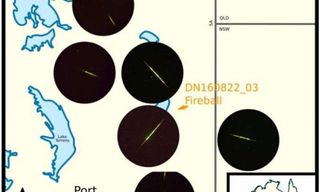A fiery meteor explosion over the Australian desert may have been an ultra-rare minimoon, researchers think.
Sometimes, objects from space come really close to Earth but are not immediately pulled in by our planet's gravity. They often orbit for a short period of time before being either pulled into the atmosphere or hurled back out into space. These objects are called temporarily captured orbiters (TCOs), but are commonly referred to as natural Earth satellites or minimoons.
In pouring over data from Australia's Desert Fireball Network (DFN) — a network of cameras set up across Australia to capture images of minimoon fireballs, or minimoons entering Earth's atmosphere and burning up — a group of researchers have identified what they think is a minimoon meteor, or fireball.
This is the second time that researchers have identified a TCO blazing through the atmosphere before hitting the ground. In finding the fireball, named DN160822_03, the researchers think that it exploded over the Australian desert on Aug. 22, 2016.
Related: Earth Has 'Minimoons,' and They May Solve Asteroid Mysteries

By studying the object's flight path around Earth, the team was able to calculate its trajectory to see what angle it entered Earth's atmosphere at (if the object entered Earth's atmosphere at a smaller angle, it suggests that it circled Earth first).
This information combined with velocity data led the researchers to conclude that, most likely, this object was orbiting Earth before being pulled in by gravity and burning up in our planet's atmosphere. This would most likely make the object a minimoon.
By studying the flight paths of minimoons like DN160822_03, researchers could better understand how we might be able to better prevent objects from getting close to Earth and how we might be able to more easily access these objects and the resources that they may possess.
As the team states in their study, which was published Oct. 14 in the Astronomical Journal, "TCOs are a crucially important subpopulation of near-Earth objects (NEOs) to understand because they are the easiest targets for future sample-return, redirection, or asteroid mining missions."
Minimoon history
This being only the second observation of a minimoon fireball, sightings of the fiery events are incredibly rare.
Only one time, in 2006, have researchers observed a minimoon orbiting Earth. The object, named 2006 RH120, was seen through a telescope circling the planet. The object orbited Earth for about 11 months before it wriggled free from Earth's gravity and was flung back out into space.
Additionally, only one other minimoon fireball has ever been observed. The fireball was spotted by a team running a camera network in Europe in 2014.
Follow Chelsea Gohd on Twitter @chelsea_gohd. Follow us on Twitter @Spacedotcom and on Facebook.

"space" - Google News
December 03, 2019 at 03:40AM
https://ift.tt/2LgiF9r
Scientists Spot Rare Minimoon Fireball Over Australia - Space.com
"space" - Google News
https://ift.tt/2Q8TIzF
Shoes Man Tutorial
Pos News Update
Meme Update
Korean Entertainment News
Japan News Update
Bagikan Berita Ini














0 Response to "Scientists Spot Rare Minimoon Fireball Over Australia - Space.com"
Post a Comment